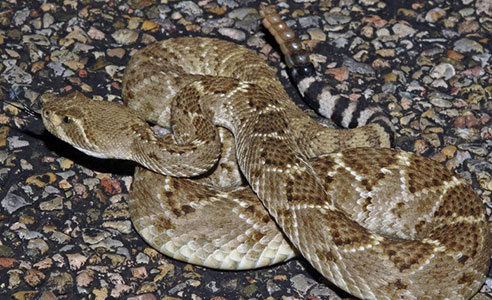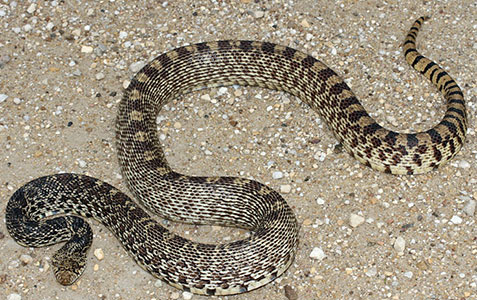
Following is a description of some of the wildlife living in the high desert area of Sundance Mesa
BIRDS
Some of the more interesting indigenous birds are:
- The cactus wren builds its football-sized nest of grass stems lined with feathers in the spiny cholla cactus. Its bony feet and a thick coat of feathers enable it to perch on cactus without being impaled.
- The hummingbird flits from plant to plant feeding on insects and flower nectar. Certain types of vegetation planted around the house will encourage the presence of these delightful little birds. The species most commonly seen in the Placitas area are the Black Chin, Broadtail and Rufus. The bright copper-colored Rufus is the most aggressive.
- The owl often sits on rooftops (particularly chimneys) emitting its eerie “who-who” to scare rodents into moving. Then they swoop down and capture the prey with their strong talons. Large owls can pick up small pets.
- The quail (or bobwhite) are a family unit of parents with numerous little ones. The father will be seen flying to a high vantage point so he can be on the lookout for predators.
- The roadrunner is the New Mexico State Bird. Roadrunners can fly, and they can run over the desert at speeds up to fifteen miles an hour. Its foot-long tail, when flicked to one side, enables the roadrunner to quickly turn in mid-stride. When the tail is spread and raised above the bird’s back, the roadrunner can brake to a quick stop. It eats insects, scorpions, spiders, centipedes, mice, bird eggs, lizards, and small snakes.
Big birds seen circling in the sky include turkey vultures, hawks, and eagles.
CENTIPEDES, SPIDERS, & SCORPIONS
The desert has all types of small crawling critters. We must share the landscape with them. Many residents have found that spraying for pests (around the foundation outside and along the baseboards and sills inside) will help control an invasion. Some of the small critters seen in this area are:
- The centipedes are arthropods with the wormlike bodies of many segments. Occasionally humans are bitten by centipedes producing a reaction like a bee sting. Centipedes feed on small insects.
- The scorpion has heavy pincers on their front legs, and they sting by injecting venom into their prey from glands in their tails. All scorpions have stingers, but most are not deadly. Scorpions keep the insect population in check. In turn they are preyed upon by bats and owls.
- The tarantula is a large (up to a six-inch leg-span) fuzzy spider. They only bite if threatened. The bite may be painful, but it is not dangerous to people. Tarantulas feed on cockroaches, crickets, scorpions, mice, and other rodents.
MAMMALS
The category includes a wide range of animals in the desert. The following are the ones typically seen in Sundance Mesa.
- The bat is a flying nocturnal mouse-like mammal that helps keep the insect population under control.
- The bobcat sports tufted ears, fringes of long whiskers, and a stubby six-inch tail. It is more than twice as large as an ordinary house cat. Bobcats are often spotted in Sundance Mesa-sometimes with one or two young ones. They usually hunt for rabbits, mice, packrats, and squirrels. They are a fierce predator and small dogs and cats, even in a walled yard, are no match against them.
- The coyote eats almost anything from grasses, nuts, and cactus fruit to mice, rabbits, insects, snakes, and lizards. They are leery of humans but can be seen skirting around houses in the neighborhood. Residents who have pets should note that coyote packs can prey on cats and dogs if presented an opportunity. Don’t let any pet run loose; it probably will not survive an attack by coyotes.
- The cottontail rabbit with its fluffy white tail visits our yards in search of water, vegetation, and a refuge from coyotes and other predators.
- The jackrabbit is a hare that has longer hind legs and longer ears than a cottontail. The long ears, while helping the jackrabbit hear better when danger is approaching, are really designed to help the animal keep cool.
- The kangaroo rat has large hind feet to keep it from sinking in the sand and a long-tufted tail that helps it keep its balance.
- The pack rat (or wooden rat) collects for its nest sticks, cactus, dung, bones, and other items that catches the pack rat’s attention. They have been known to build “multi-story condominiums” in wood piles. Be careful when taking wood off your wood pile. Avoid contact with the rats and their nests.
REPTILES
Snakes and lizards are true survivors in the desert, given they have no means of controlling body temperature, they avoid getting too much heat. That’s why you see lizards moving in and out of the shade during the daytime, when they are the most active. The gecko includes a wide variety of house lizards that climb vertical surfaces. They often cleanup insects around the house.
In cooler weather, snakes can be found in sunny places. At night they sometimes lay on roads or walkways that retain heat. In hot weather snakes hunt primarily at night, when it is cooler. But you can see snakes moving around during the day, and when they come to a house they will generally follow the foundation line around the building as they hunt for a shady place. If you leave your garage door open in warm weather, you are inviting snakes to enter. When you’re working in your yard, be aware that snakes like to curl up under shrubs to get out of the sun, so be careful.
The snakes of Sundance Mesa include:
- The rattlesnake. There are only two species of rattlesnake in the Placitas area. The Black Tailed rattlesnake lives against the foothills, but in Sundance Mesa the only rattlesnake seen is the Western Diamondback. It can measure four feet in length. Its color often matches or blends in with the soil. It has a wide triangle shaped head. From mid-September to the beginning of October, rattlesnakes begin to migrate to their dens where they hibernate throughout the winter months. They leave their dens in the springtime, around the beginning to the middle of April. The rattlesnake is the only poisonous snake in Placitas.

- The bull snake is a golden color with brown markings. Some mistake it for a rattlesnake, but it has a slender body and a narrow head unlike the broader head of the rattlesnake. It has no rattler and is non-venomous. The bull snake is a constrictor and they are very beneficial in helping to control the rodent population.

- The coachwhip or red racer has a coloration of tan, grey, red, or pink and bold black or brown crossbars or blotches on the neck. An adult can obtain a length of 8 ½ feet. They are fast movingsnakes, and although non-venomous they do not have a pleasant disposition.

RODENT DISEASES
A bit of caution can help protect you from rodent diseases that exist in New Mexico.
- Hantavirus is a respiratory disease carried by rodents. It is found in the urine, saliva, and feces of deer mice. Breathing the airborne particles is the primary way to contract the disease. With any contact wash thoroughly with soap and water. Removing rodents or cleaning up after them should be done with extreme care or by calling a professional service. If you decide to clean the area yourself wear a mask and finish up the cleaning process by using a disinfectant.
- Plague is a bacterial disease passed to man by wild rodents, rabbits, and their fleas. Keep rodents out of your house by sealing all holes and cracks. Putting steel wool around pipes and beams will prevent rodents from being able to slip into your house through these small openings. Rodents are attracted by bird feed and garbage. Your dog or cat can bring plague-infected fleas and animals into your home. Pets that may encounter rodents should have good flea and tick protection.
